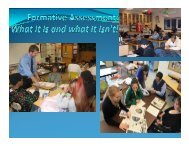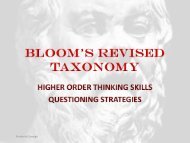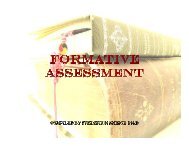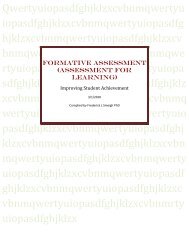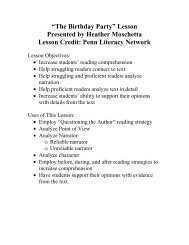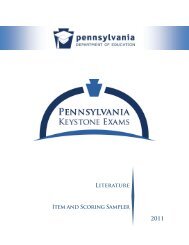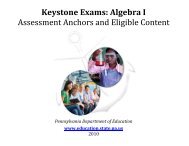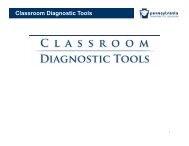PSSA Accommodations Guidelines for Students with IEPs and
PSSA Accommodations Guidelines for Students with IEPs and
PSSA Accommodations Guidelines for Students with IEPs and
Create successful ePaper yourself
Turn your PDF publications into a flip-book with our unique Google optimized e-Paper software.
Pennsylvania Department of Education<br />
<strong>Accommodations</strong> <strong>Guidelines</strong> <strong>for</strong> <strong>Students</strong> <strong>with</strong> <strong>IEPs</strong> <strong>and</strong> <strong>Students</strong> <strong>with</strong> 504 Plans<br />
Part 2: Learn about <strong>Accommodations</strong> <strong>for</strong> Instruction<br />
<strong>and</strong> Assessment<br />
WHAT ARE ACCOMMODATIONS?<br />
<strong>Accommodations</strong> are practices <strong>and</strong> procedures in the areas of presentation, response, setting,<br />
<strong>and</strong> timing/scheduling that provide equitable access during instruction <strong>and</strong> assessments <strong>for</strong><br />
students <strong>with</strong> disabilities.<br />
<strong>Accommodations</strong> are intended to reduce or even eliminate the effects of a student’s<br />
disability; they do not reduce learning expectations. IEP teams or 504 case managers make<br />
decisions about accommodations based upon classroom instruction. It is critical to note that<br />
although some accommodations may be appropriate <strong>for</strong> instructional use, they may not be<br />
appropriate <strong>for</strong> use on a st<strong>and</strong>ardized assessment. For example, the <strong>PSSA</strong> <strong>and</strong> <strong>PSSA</strong>-M<br />
reading assessment measures, in part, how well a student can decode, or make sense of,<br />
printed text. If the reading passages <strong>and</strong> items are read aloud to a student, however, it may<br />
become an assessment of listening skills <strong>and</strong> not of reading skills. It is very important <strong>for</strong><br />
educators to become familiar <strong>with</strong> state policies regarding accommodations during<br />
assessments.<br />
Typically, accommodation use does not begin <strong>and</strong> end in school. <strong>Students</strong> who use<br />
accommodations generally also will need them at home, in the community, <strong>and</strong> as they get<br />
older, in postsecondary education <strong>and</strong> at work. <strong>Accommodations</strong> <strong>for</strong> instruction <strong>and</strong><br />
assessment are integrally intertwined.<br />
DESCRIPTION OF ACCOMMODATIONS CATEGORIES<br />
<strong>Accommodations</strong> <strong>for</strong> instruction <strong>and</strong> assessment are commonly categorized in these ways:<br />
presentation, response, setting, <strong>and</strong> timing/scheduling:<br />
Presentation <strong>Accommodations</strong>—Allow students to access print in<strong>for</strong>mation in<br />
alternate ways. These alternate modes of access are auditory, multi-sensory,<br />
tactile, <strong>and</strong> visual. [Table 1]<br />
Response <strong>Accommodations</strong>—Allow students to complete activities, assignments,<br />
<strong>and</strong> assessments in different ways or to solve or organize problems using some<br />
type of assistive device or organizer. [Table 2]<br />
Setting <strong>Accommodations</strong>—Change the location in which a test or assignment is<br />
given or the conditions of the assessment setting. [Table 3]<br />
Timing/Scheduling <strong>Accommodations</strong>—Increase the allowable length of time to<br />
complete an assessment or assignment <strong>and</strong> perhaps change the way the time is<br />
The Keystone Exams will not be administered 2011-2012 12 1/24/2012



